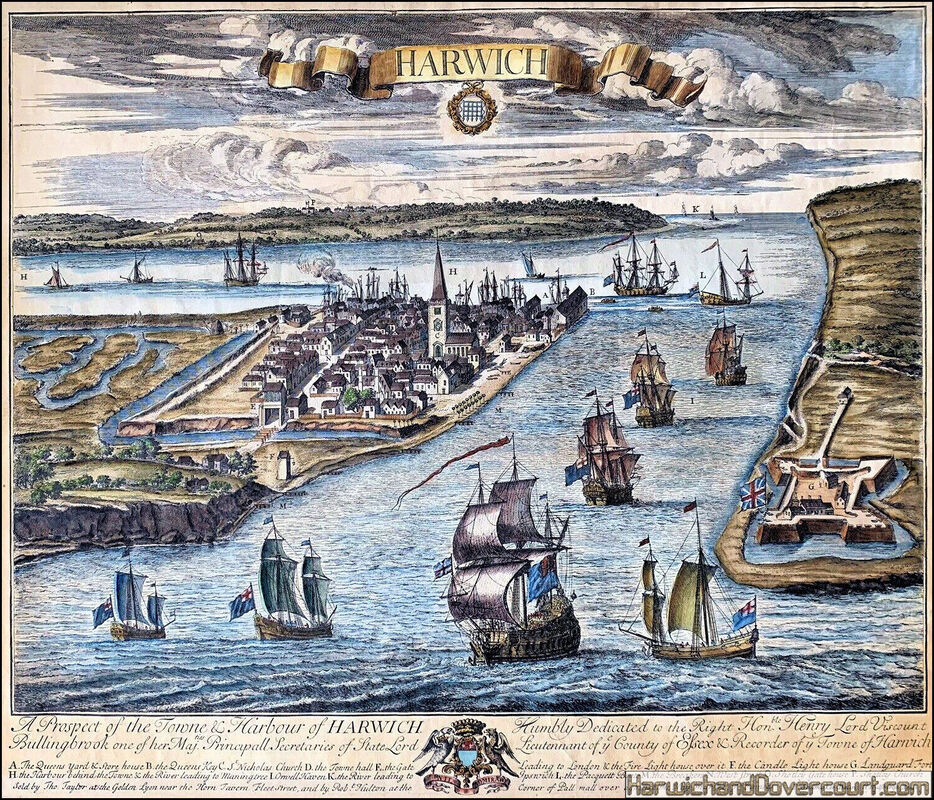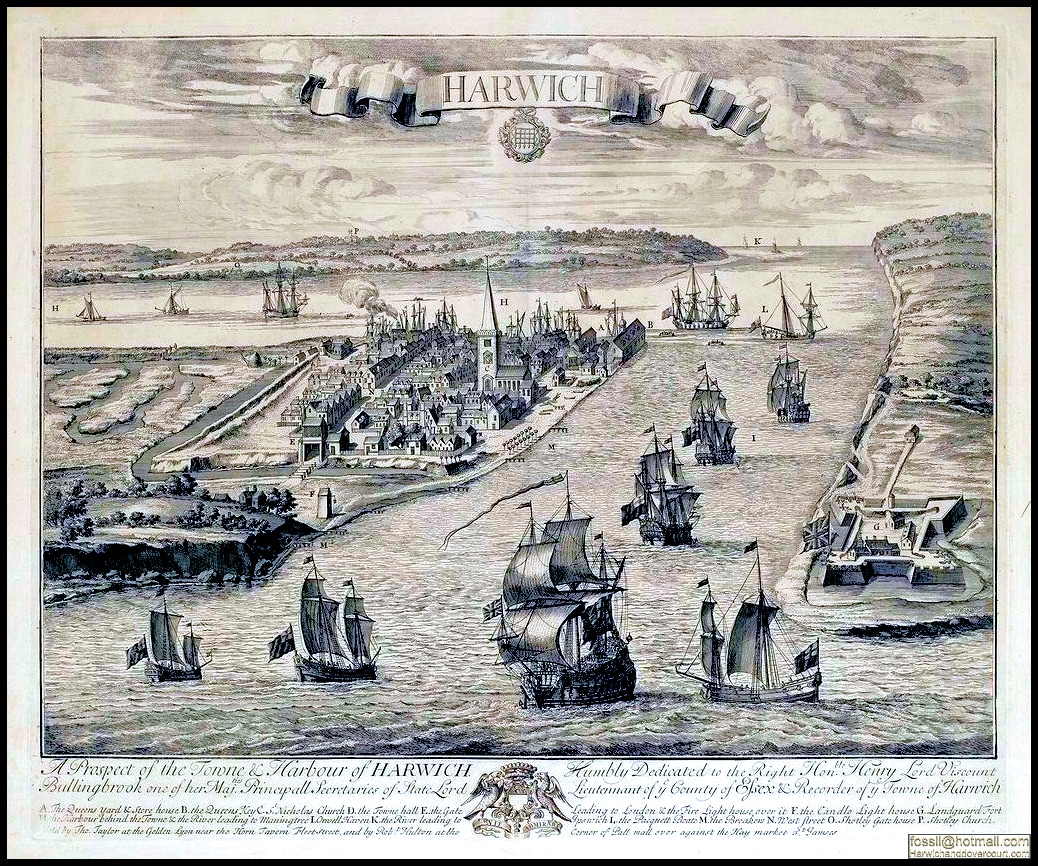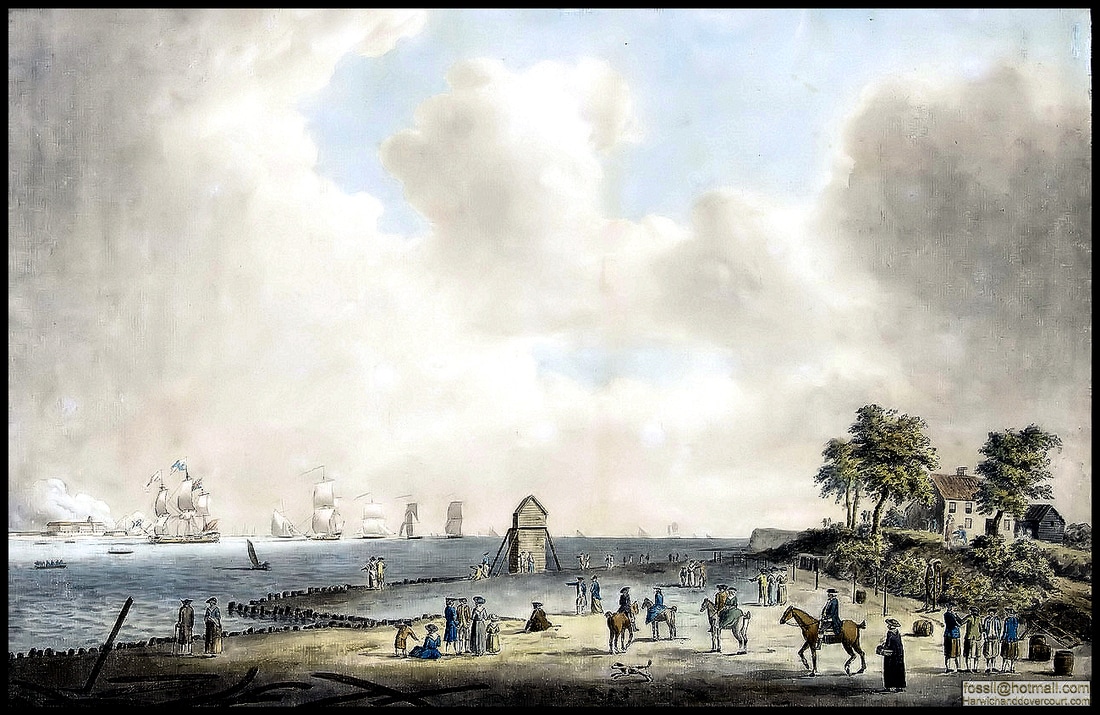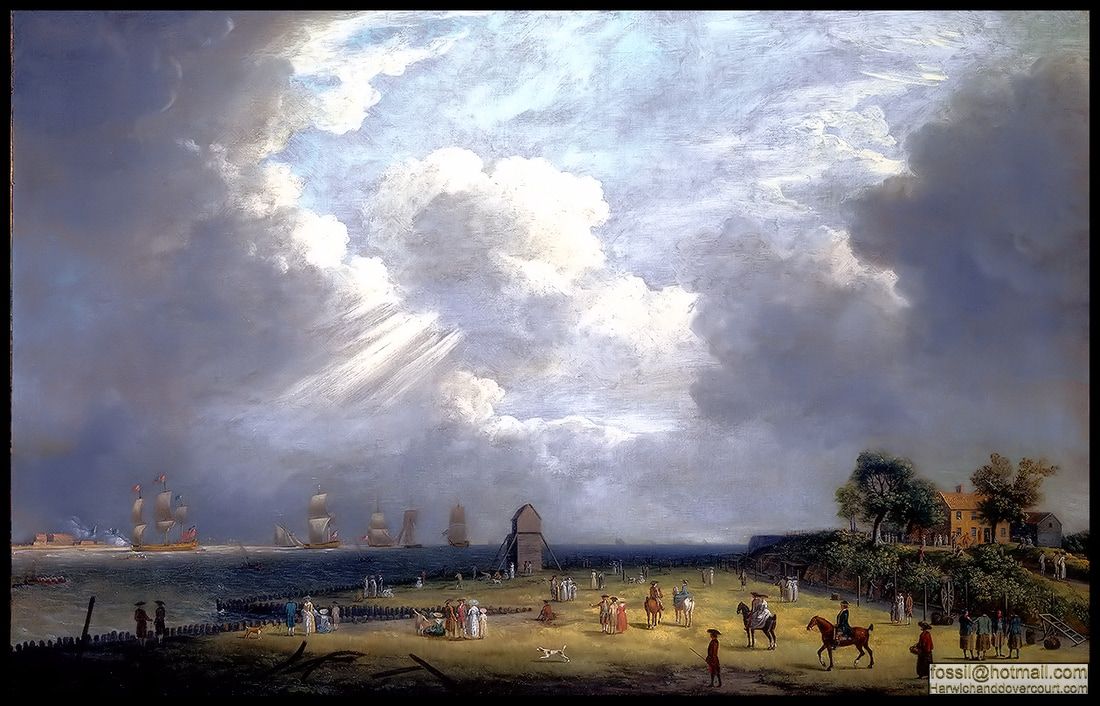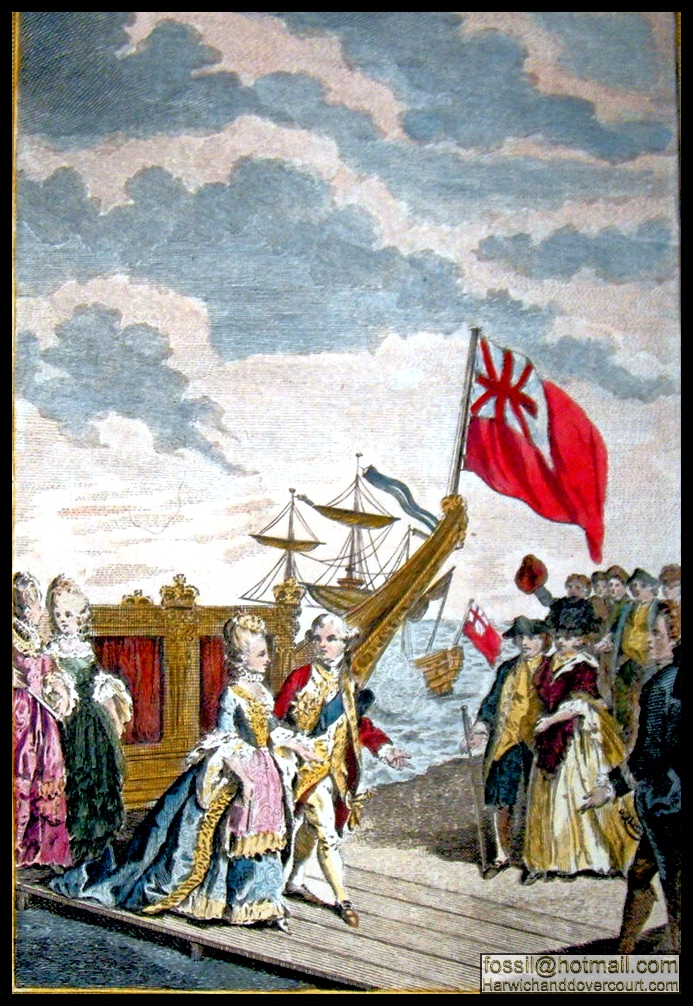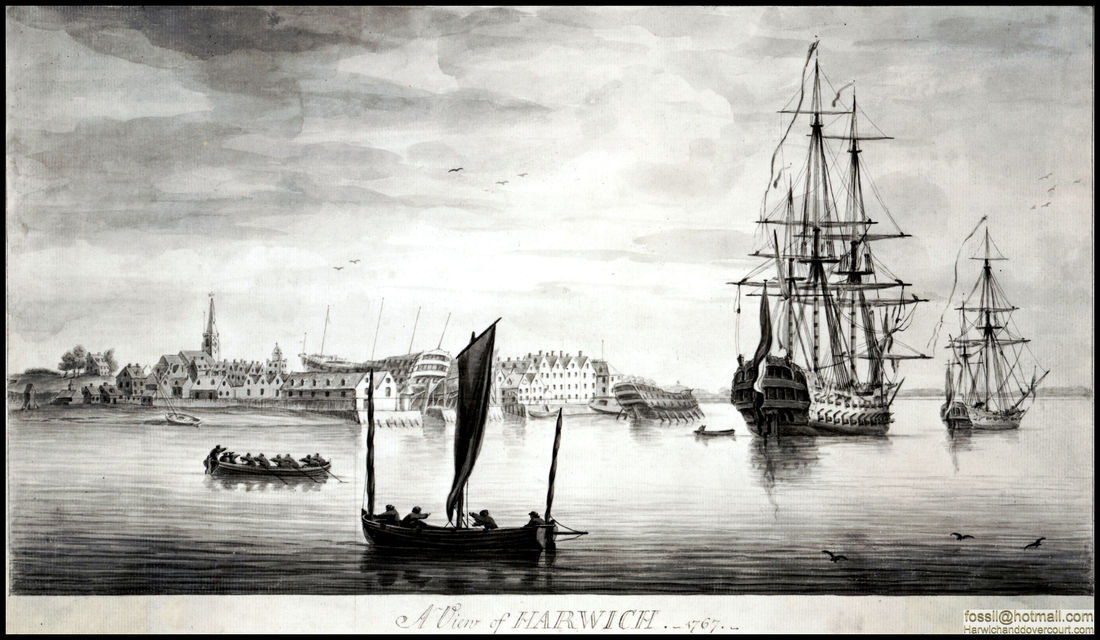1748 ~ John Cleveley the Elder - "A Launching at Harwich" ~
1748 ~John Cleveley ~ "The Landing of Princess Charlotte of Mecklenburg-Strelitz at Harwich" ~
~ 1720 ~ A Prospect of the town and Harbour of Harwich ~ Publisher: Robert Hulton ~
A Fine 18th century engraving by Johannes Kip (1653-1722) Entitled “A Prospect of the Towne & Harbour of Harwich” published circa 1720 with additional hand colouring
This particular copper engraving appears to be one of the earliest copies to exist. It was originally engraved by Kip, while Isaac Sailmaker (1633-1721) was the "delineator" and the "hand colouring" was carried out by a Hendrick Hulsbergh (1660-1729). The details of both men are noted in the lower right-hand corner of this engraving, with all three men, being of Dutch origin.
The word “Delin” on old prints means "drew" in Latin. The name following is the artist who did the drawing that the print reproduces.
The word “Sculp” shows the that the print is an engraving. The name following this will be that of the engraver.
Later examples possibly produced around 1750 (as stated in the British Museum) show no such signatures, which was possibly due to deteriorating relationships between Great Britain and Holland and the subsequent fourth Anglo-Dutch War in 1780. A link to the Government's Art collection is shown below:
https://artcollection.culture.gov.uk/artwork/5616/
This detailed engraving, shows a bird’s-eye-view of the town and harbour of Harwich in Essex, it is coloured with washes of watercolour. The town of Harwich and the meeting of the River Stour and the River Orwell are seen, as they appeared in the early 18th century. In the distance is a church in the village of Shotley, on a peninsula between the two rivers. The main buildings and features are identified in a lettered key below the image and include the ‘Lighthouse’, ‘St. Nicholas' Church’ in Harwich, ‘Shotley Church’ and 'Shotley gate house'.
Johannes Kip (1653-1722) was a draftsman and engraver, who was a native of Amsterdam. He was a pupil of Bestiaen Stopendeal from 1668 to 1670. He worked first in his native Amsterdam before moving to London at the end of the seventeenth century. He did portraits, views, and book illustrations. His most important work was this lovely and informative series of bird's-eye views of English countryseats. Kip originally collaborated on this project with a fellow Dutch artist, Leonard Knyff. Knyff did the drawings and Kip the etchings. But as the project developed, Kip created his own drawings as well as doing the etchings. The earliest dated prints by Kip are from 1672, and numerous printed topographical views and portraits followed. Winning the attention of the court of William of Orange, he etched six plates of William of Orange, his wife, Mary, and attendants in 1686. In 1689, William and Mary were made King and Queen of Great Britain, and Kip followed the court to England. Kip settled in Westminster where he continued his work.
Isaac Sailmaker was known as 'the father of British sea painting'. He ranks among the country's first marine artists. Born in Holland, he came to England very young and worked in the household of art dealer George Geldorf, developing a style that provided a highly detailed record of the British navy. His hand is recognizable through substantial clues. He almost always worked within a restrained palette primarily of greys, greens, and black. His paintings of Eddystone Lighthouse are amongst the best known and most highly valued.
Hendrick Hulsbergh was a Dutch engraver of maps and architecture who worked in London from at least 1709 onwards.
Born in Amsterdam, Hulsbergh was in London by 1709. He was mainly employed on engraving large architectural compositions: for Colen Campbell's Vitruvius Britannicus, Kip's Britannia Illustrata, and Christopher Wren's Designs for St. Paul's Cathedral. He also engraved portraits, including one of Georg Andreas Ruperti, pastor of the Dutch Church in London in 1709. Hulsberg was warden of the Lutheran Church in the Savoy Hospital and was supported by the congregation and the brethren of a Dutch club during two years of continued illness and incapacity for work. He died in May 1729 of a paralytic fit and was buried in the Savoy.
This particular copper engraving appears to be one of the earliest copies to exist. It was originally engraved by Kip, while Isaac Sailmaker (1633-1721) was the "delineator" and the "hand colouring" was carried out by a Hendrick Hulsbergh (1660-1729). The details of both men are noted in the lower right-hand corner of this engraving, with all three men, being of Dutch origin.
The word “Delin” on old prints means "drew" in Latin. The name following is the artist who did the drawing that the print reproduces.
The word “Sculp” shows the that the print is an engraving. The name following this will be that of the engraver.
Later examples possibly produced around 1750 (as stated in the British Museum) show no such signatures, which was possibly due to deteriorating relationships between Great Britain and Holland and the subsequent fourth Anglo-Dutch War in 1780. A link to the Government's Art collection is shown below:
https://artcollection.culture.gov.uk/artwork/5616/
This detailed engraving, shows a bird’s-eye-view of the town and harbour of Harwich in Essex, it is coloured with washes of watercolour. The town of Harwich and the meeting of the River Stour and the River Orwell are seen, as they appeared in the early 18th century. In the distance is a church in the village of Shotley, on a peninsula between the two rivers. The main buildings and features are identified in a lettered key below the image and include the ‘Lighthouse’, ‘St. Nicholas' Church’ in Harwich, ‘Shotley Church’ and 'Shotley gate house'.
Johannes Kip (1653-1722) was a draftsman and engraver, who was a native of Amsterdam. He was a pupil of Bestiaen Stopendeal from 1668 to 1670. He worked first in his native Amsterdam before moving to London at the end of the seventeenth century. He did portraits, views, and book illustrations. His most important work was this lovely and informative series of bird's-eye views of English countryseats. Kip originally collaborated on this project with a fellow Dutch artist, Leonard Knyff. Knyff did the drawings and Kip the etchings. But as the project developed, Kip created his own drawings as well as doing the etchings. The earliest dated prints by Kip are from 1672, and numerous printed topographical views and portraits followed. Winning the attention of the court of William of Orange, he etched six plates of William of Orange, his wife, Mary, and attendants in 1686. In 1689, William and Mary were made King and Queen of Great Britain, and Kip followed the court to England. Kip settled in Westminster where he continued his work.
Isaac Sailmaker was known as 'the father of British sea painting'. He ranks among the country's first marine artists. Born in Holland, he came to England very young and worked in the household of art dealer George Geldorf, developing a style that provided a highly detailed record of the British navy. His hand is recognizable through substantial clues. He almost always worked within a restrained palette primarily of greys, greens, and black. His paintings of Eddystone Lighthouse are amongst the best known and most highly valued.
Hendrick Hulsbergh was a Dutch engraver of maps and architecture who worked in London from at least 1709 onwards.
Born in Amsterdam, Hulsbergh was in London by 1709. He was mainly employed on engraving large architectural compositions: for Colen Campbell's Vitruvius Britannicus, Kip's Britannia Illustrata, and Christopher Wren's Designs for St. Paul's Cathedral. He also engraved portraits, including one of Georg Andreas Ruperti, pastor of the Dutch Church in London in 1709. Hulsberg was warden of the Lutheran Church in the Savoy Hospital and was supported by the congregation and the brethren of a Dutch club during two years of continued illness and incapacity for work. He died in May 1729 of a paralytic fit and was buried in the Savoy.
~ 1750 ~ A later uncoloured version of "A Prospect of the town and Harbour of Harwich" ~ Publisher: R.Hulton ~
1761 ~ The Arrival of Princess Charlotte at Harwich, September 1761 ~ Dominic Serres
This watercolour suggests that Serres was present at Harwich in September 1761 to witness the arrival from Germany of Princess Charlotte on board the 'Royal Charlotte', prior to her marriage to George III. The squadron, commanded by Lord Anson, is visible in the background, with the 'Royal Charlotte' off Landguard Fort. The drawing is signed with initials and dated 1761, and inscribed 'The Queen's Arrival at Harwich'. A group of sailors is included in the right hand corner of the drawing. An oil painting of exactly the same subject, also in the Museum's collection, was exhibited by Serres at the Free Society of Artists in 1763.
1763 ~ The Arrival of Princess Charlotte at Harwich, September 1761 ~ Dominic Serres
Following the accession of King George III in 1760 the choice of a bride for him fell upon Princess Charlotte of Mecklenburg-Strelitz. A squadron of yachts and men-of-war under the Admiral of the Fleet, Lord Anson, was sent to Cuxhaven on the German coast to collect her. The principal yacht, the 'Royal Caroline', was renamed 'Royal Charlotte', and sumptuously fitted out for the Princess. Westerly gales blew the returning squadron over to the Norwegian coast three times, so it was ten days before it reached Harwich. Serres visited Harwich in September 1761 to record the arrival of the Princess and his picture shows this much delayed event in Harwich harbour, with sunlight breaking through the clouds onto the 'Royal Charlotte', as she passes Landguard Fort. In the foreground the artist has shown many onlookers including a group of sailors on the right. Beyond them a ropewalk is visible as well as the wooden lighthouse beacon in the centre of the picture. This was used by seamen as an aid to navigation into Harwich harbour, together with Pain's Tree shown to the right. Serres named one of his daughters Charlotte at about this time, when he was becoming established as England's leading marine painter. Serres was a well-born Frenchman from Gascony who ran away to sea in merchant service rather than follow family wish that he enter the Church. He probably arrived in England as a naval prisoner of war, took up painting and settled there. His early paintings show the influence of Brooking and Monamy's interpretations of Dutch art but he rapidly achieved recognition for his more documentary visual accounts of sea actions of the Seven Years War, 1756-63. His work was even more in demand in the 1770s and 1780s, recording the naval history of the War of American Independence. In 1768 Serres was a founder member of the Royal Academy and at the end of his life its librarian. A well-respected and sociable man, he was appointed Marine Painter to George III in 1780.
Off Harwich 1761, with Treadmill Wheel-crane and Ship Building.
John Cleveley the Elder (Southwark circa 1712-1777 Deptford)
The flotilla of ships, led by the Royal Charlotte in company with five other royal yachts, arriving off Harwich on 6 September 1761, after conveying Princess Charlotte of Mecklenburg-Strelitz to England for her marriage to George III
oil on canvas
John Cleveley the Elder (Southwark circa 1712-1777 Deptford)
The flotilla of ships, led by the Royal Charlotte in company with five other royal yachts, arriving off Harwich on 6 September 1761, after conveying Princess Charlotte of Mecklenburg-Strelitz to England for her marriage to George III
oil on canvas
1761 ~ Her Majesty Queen Charlotte landing at Harwich on her way to St. James's Palace Sept 7 1761 ~
~ Engraved for Raymond's History of England ~
~ Engraved for Raymond's History of England ~

